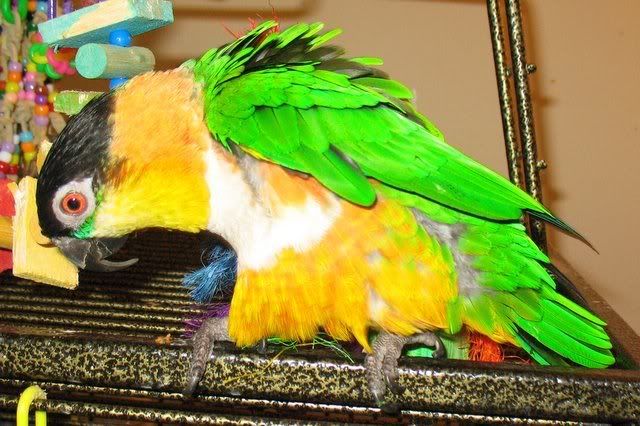First, Steve. He found all of his hidden pellets yesterday, so today I went with 15 hidden and 5 in his dish, but still wrapped. Again, before I left for work, he had found and eaten many of the hidden pellets. In this picture, he has one in his foot (though you can't see it because a toy is in the way) and you can see a couple of wrapped pellets in his blue plastic toy, waiting for him to find them:
 A short video of Steve finding a pellet:
A short video of Steve finding a pellet:Eating a wrapped pellet, from a different angle:
 I put wrapped pellets in the caiques' cages, and Beeps had eaten three before I left for work.
I put wrapped pellets in the caiques' cages, and Beeps had eaten three before I left for work.Also, I was wrapping the pellets at the kitchen table this morning, and Rocky climbed up and ate two wrapped pellets. He never eats pellets in the kitchen! Therefore, I will be wrapping and hiding pellets for all of the parrots. My bird sitter might kill me the next time we go on vacation with all of this extra work for her!
Lisa had asked if foraging is fun for all parrots. As I replied in my comment, I can only talk about the parrots in my house, but they all love it! I'm only sad that I didn't start earlier with Rocky and the caiques. I'm sure I'll be updating more on this topic in the future.
Starting foraging is really easy. There are many different ways to make your birds find their food. The way I do it is by wrapping pellets in adding machine tape and then hiding the wrapped pellets in toys in their cages. You can buy special foraging toys, but almost any toy can be used to hide a pellet. I do tend to buy more complicated foraging toys for the greys, to make things more challenging for them.
The key to making this successful is starting slow, watching what your bird can handle, and making accommodations for that. Your bird may require a week or more at each step, or maybe only a day or two, depending on his/her personality.
These are the steps I've taken. For this example, let's assume that the bird gets 20 pellets per day.
Beginning foraging steps:
1. Wrap 10 pellets and leave 10 pellets unwrapped in food dish. If bird will take food from your hand, maybe offer him a wrapped pellet to pique his interest.
2. Wrap all of the pellets in the food dish.
3. Leave 15 wrapped pellets in the food dish and hide 5 wrapped pellets in his cage. Hide the pellets in obvious places, or places near where he frequently perches.
4. Work up to hiding all of the pellets.
5. Start hiding some pellets in trickier or harder to find places.
That's it!
I feed Harrison's, which lends itself quite nicely to this. If I were still feeding Zupreem, I'm not sure how I would do this. Maybe wrap 2-3 pellets in each paper square?


3 comments:
I hide small bits of food all the time for Harley by wrapping them up in paper like a "Christmas Cracker" - cut up bits of nuts, a couple of safflower seeds, or a few of Harrison's "fine" pellets. Because, you know, Harley is too dainty to eat the course size unless I cut them into pieces, soak them in a bit of water, and then present them to him in a spoon. Yeah, that didn't last long!
I have pics and a description here: http://www.thefinsters.com/flog/item-1217.html
Steve's face is just wonderful! Oh, if only we knew what these marvelous creatures thought!
when we started encouraging Jasmine to forage for pellets, we introduced her to the wrapped pellets one evening in her food bowl. The did a classic double-take when she got to the bowl and saw something other than what she expected, it had us both in fits.
We had to reach into the bowl and take one each, unwrap it and eat it, to show her what it was all about. She quickly caught on, of course.
Post a Comment